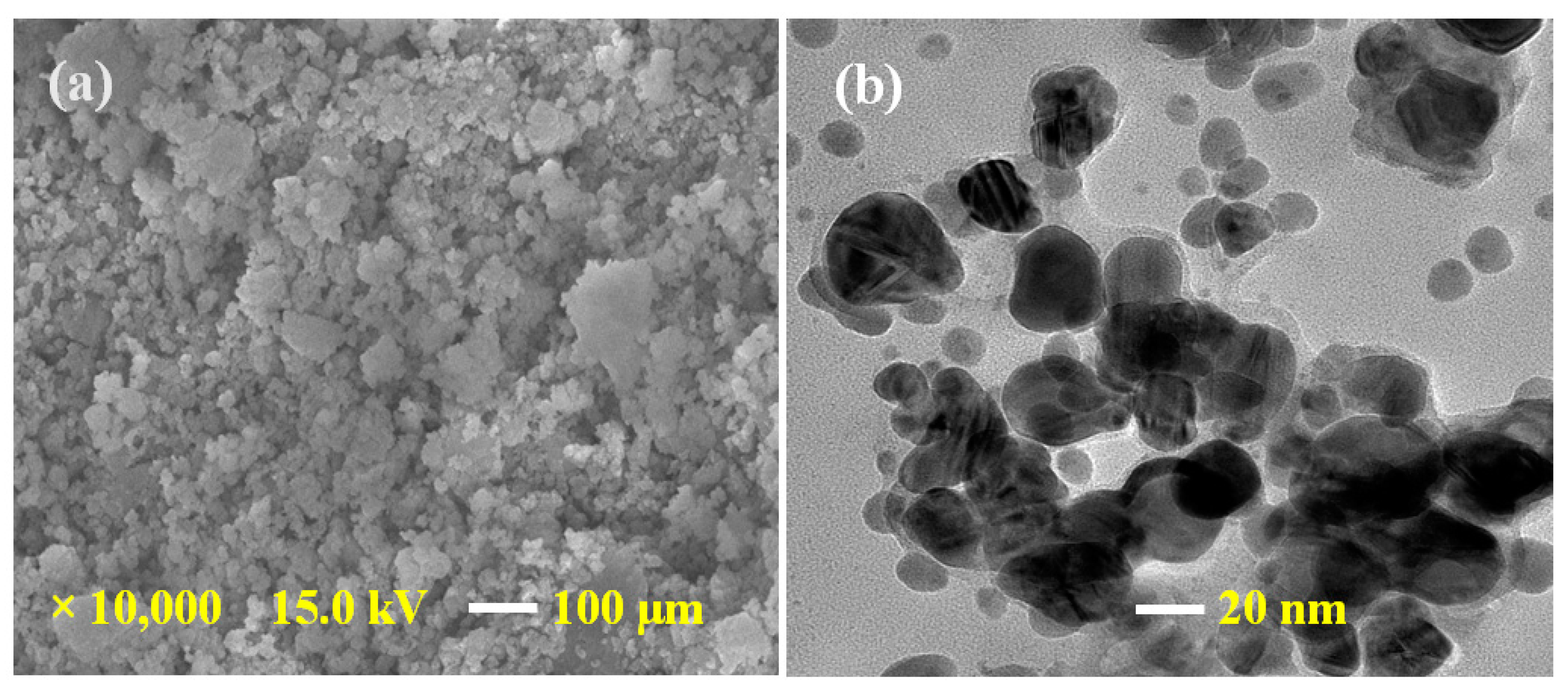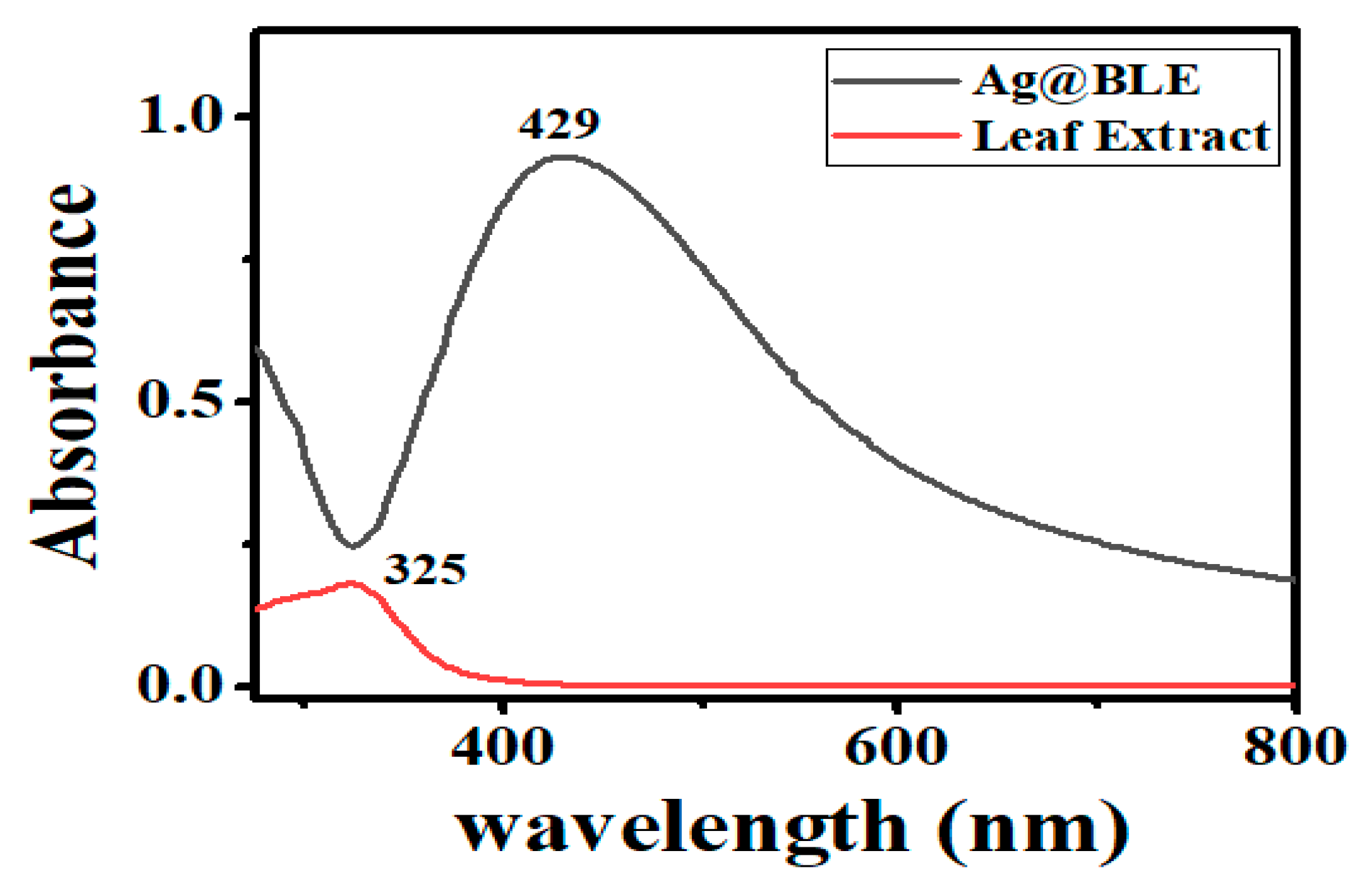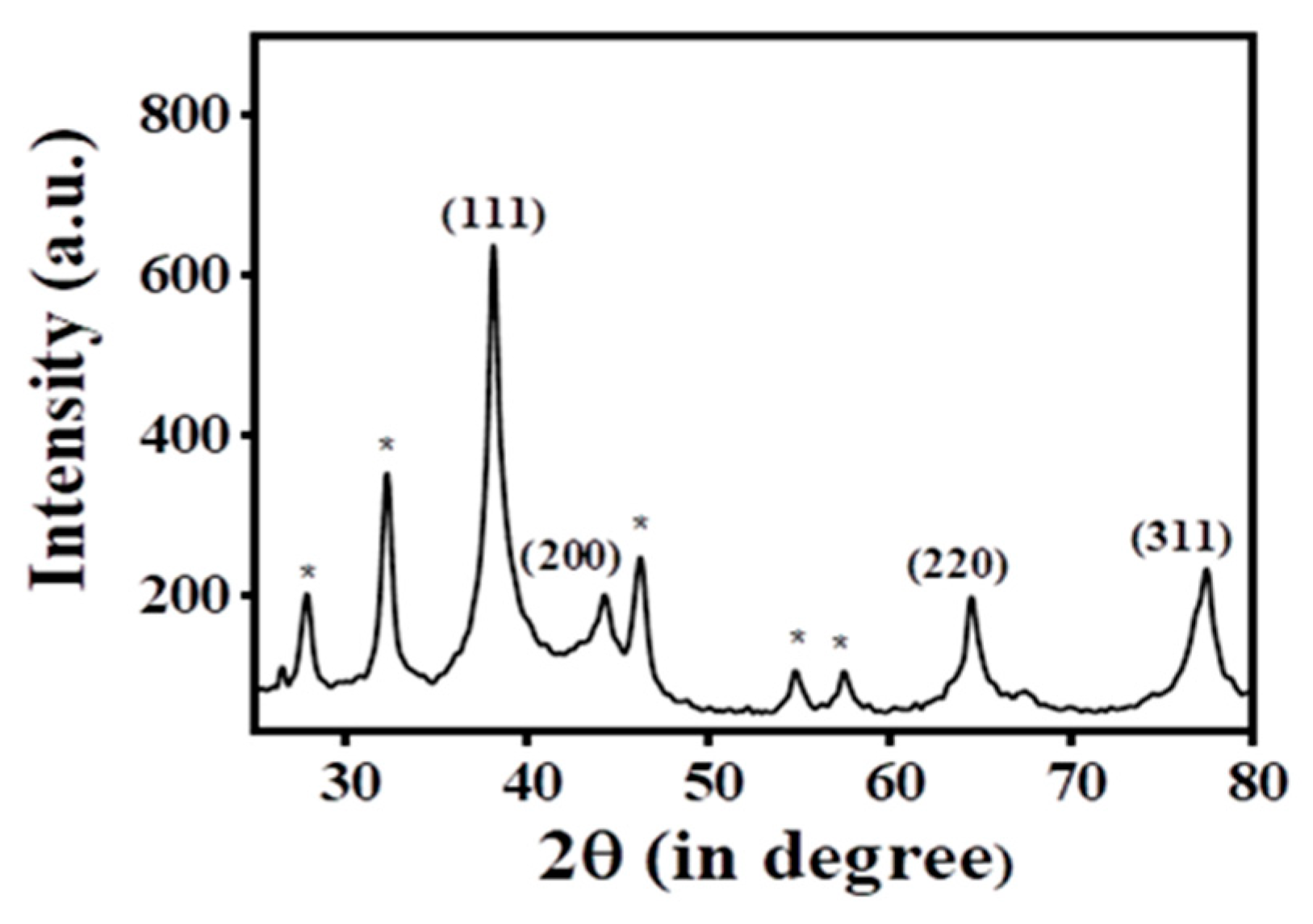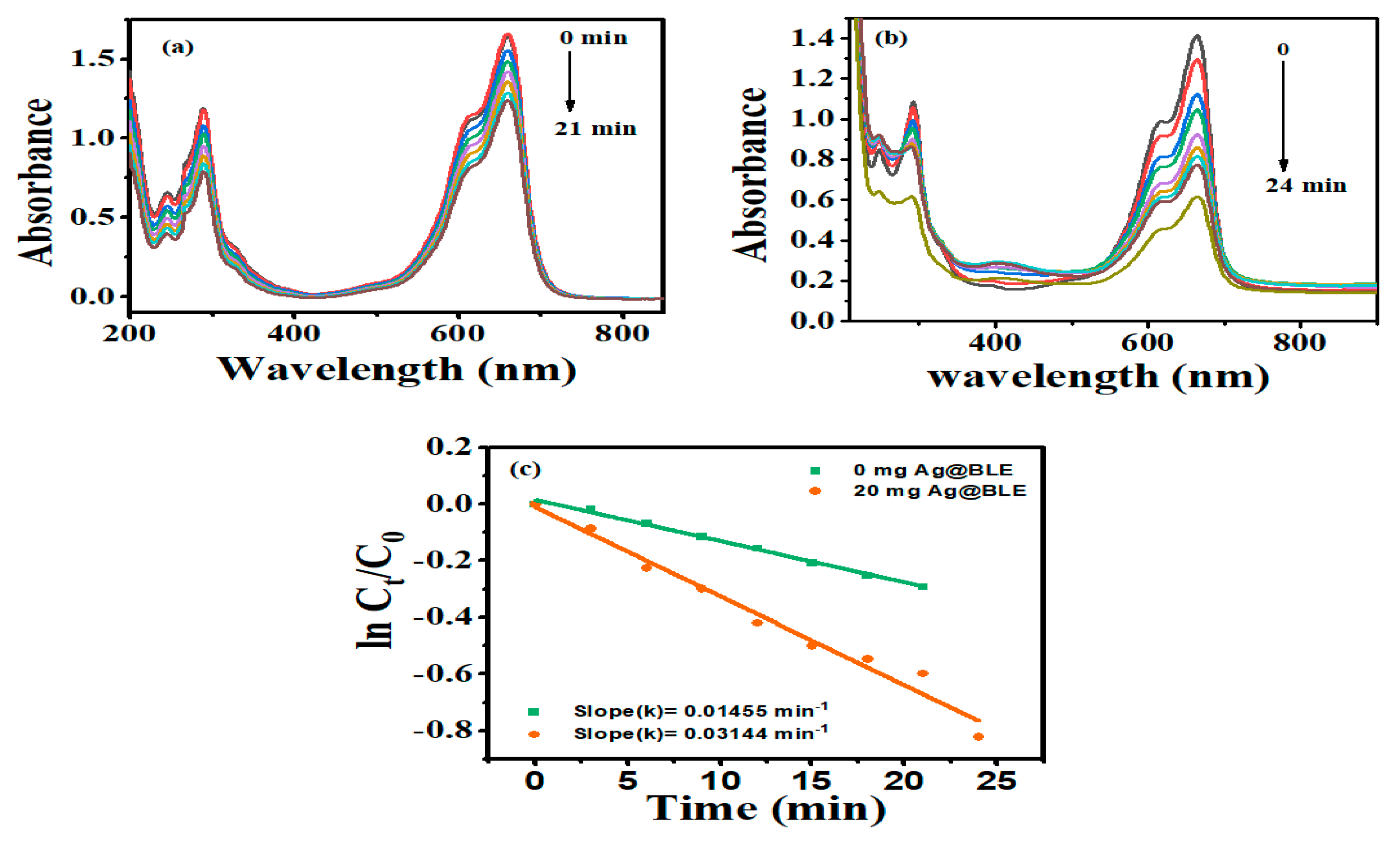Catalytic Dye Degradation of Textile Dye Methylene Blue by Using Silver Nanoparticles Fabricated by Sustainable Approach †
Abstract
:1. Introduction
2. Materials and Methods
3. Results and Discussion
3.1. Morphological Studies
3.2. UV–Visible Analysis
3.3. Powder X-ray Diffraction (PXRD) Analysis
3.4. Fourier Transform Infrared Analysis
4. Catalytic Performance of Ag@BLE NPs in the Degradation of the Textile Dye Methylene Blue (MB)
5. Conclusions
Author Contributions
Funding
Institutional Review Board Statement
Informed Consent Statement
Data Availability Statement
Acknowledgments
Conflicts of Interest
References
- Seku, K.; Hussaini, S.S.; Pejjai, B.; Al Balushi, M.M.S.; Dasari, R.; Golla, N.; Reddy, G.B. A rapid microwave-assisted synthesis of silver nanoparticles using Ziziphus jujuba Mill fruit extract and their catalytic and antimicrobial properties. Chem. Pap. 2020, 75, 1341–1354. [Google Scholar] [CrossRef]
- Vykoukal, V.; Zelenka, F.; Bursik, J.; Kana, T.; Kroupa, A.; Pinkas, J. Thermal properties of Ag@Ni core-shell nanoparticles. Calphad 2020, 69, 101741. [Google Scholar] [CrossRef]
- Wiley, B.J.; Chen, Y.; McLellan, J.M.; Xiong, Y.; Li, Z.-Y.; Ginger, D.; Xia, Y. Synthesis and Optical Properties of Silver Nanobars and Nanorice. Nano Lett. 2007, 7, 1032–1036. [Google Scholar] [CrossRef] [PubMed]
- Saini, I.; Rozra, J.; Chandak, N.; Aggarwal, S.; Sharma, P.; Sharma, A. Tailoring of electrical, optical and structural properties of PVA by addition of Ag nanoparticles. Mater. Chem. Phys. 2013, 139, 802–810. [Google Scholar] [CrossRef]
- Gangwar, C.; Yaseen, B.; Kumar, I.; Singh, N.K.; Naik, R.M. Growth Kinetic Study of Tannic Acid Mediated Monodispersed Silver Nanoparticles Synthesized by Chemical Reduction Method and Its Characterization. ACS Omega 2021, 6, 22344–22356. [Google Scholar] [CrossRef]
- AlNadhari, S.; Al-Enazi, N.M.; Alshehrei, F.; Ameen, F. A review on biogenic synthesis of metal nanoparticles using marine algae and its applications. Environ. Res. 2020, 194, 110672. [Google Scholar] [CrossRef]
- Anandalakshmi, K.; Venugobal, J.; Ramasamy, V. Characterization of silver nanoparticles by green synthesis method using Pedalium murex leaf extract and their antibacterial activity. Appl. Nanosci. 2015, 6, 399–408. [Google Scholar] [CrossRef]
- Gangwar, C.; Yaseen, B.; Kumar, I.; Nayak, R.; Sarkar, J.; Baker, A.; Kumar, A.; Ojha, H.; Singh, N.K.; Naik, R.M. Nano palladium/palladium oxide formulation using Ricinus communis plant leaves for antioxidant and cytotoxic activities. Inorg. Chem. Commun. 2023, 149, 110417. [Google Scholar] [CrossRef]
- Kumar, I.; Gangwar, C.; Yaseen, B.; Pandey, P.K.; Mishra, S.K.; Naik, R.M. Kinetic and Mechanistic Studies of the Formation of Silver Nanoparticles by Nicotinamide as a Reducing Agent. ACS Omega 2022, 7, 13778–13788. [Google Scholar] [CrossRef] [PubMed]
- Chandra, R.; Nath, M. Controlled synthesis of AgNPs@ZIF-8 composite: Efficient heterogeneous photocatalyst for degradation of methylene blue and congo red. J. Water Process Eng. 2020, 36, 101266. [Google Scholar] [CrossRef]
- Mehata, M.S. Green route synthesis of silver nanoparticles using plants/ginger extracts with enhanced surface plasmon resonance and degradation of textile dye. Mater. Sci. Eng. B 2021, 273, 115418. [Google Scholar] [CrossRef]
- Gola, D.; Kriti, A.; Bhatt, N.; Bajpai, M.; Singh, A.; Arya, A.; Chauhan, N.; Srivastava, S.K.; Tyagi, P.K.; Agrawal, Y. Silver nanoparticles for enhanced dye degradation. Curr. Res. Green Sustain. Chem. 2021, 4, 100132. [Google Scholar] [CrossRef]
- Nazari, N.; Kashi, F.J. A novel microbial synthesis of silver nanoparticles: Its bioactivity, Ag/Ca-Alg beads as an effective catalyst for decolorization Disperse Blue 183 from textile industry effluent. Sep. Purif. Technol. 2020, 259, 118117. [Google Scholar] [CrossRef]
- Pandey, S.; Do, J.Y.; Kim, J.; Kang, M. Fast and highly efficient catalytic degradation of dyes using κ-carrageenan stabilized silver nanoparticles nanocatalyst. Carbohydr. Polym. 2019, 230, 115597. [Google Scholar] [CrossRef]
- Mavaei, M.; Chahardoli, A.; Shokoohinia, Y.; Khoshroo, A.; Fattahi, A. One-step Synthesized Silver Nanoparticles Using Isoimperatorin: Evaluation of Photocatalytic, and Electrochemical Activities. Sci. Rep. 2020, 10, 1762. [Google Scholar] [CrossRef]
- Chandhru, M.; Rani, S.K.; Vasimalai, N. Reductive degradation of toxic six dyes in industrial wastewater using diaminobenzoic acid capped silver nanoparticles. J. Environ. Chem. Eng. 2020, 8, 104225. [Google Scholar] [CrossRef]
- Seerangaraj, V.; Sathiyavimal, S.; Shankar, S.N.; Nandagopal, J.G.T.; Balashanmugam, P.; Al-Misned, F.A.; Shanmugavel, M.; Senthilkumar, P.; Pugazhendhi, A. Cytotoxic effects of silver nanoparticles on Ruellia tuberosa: Photocatalytic degradation properties against crystal violet and coomassie brilliant blue. J. Environ. Chem. Eng. 2021, 9, 105088. [Google Scholar] [CrossRef]
- Rajkumar, R.; Ezhumalai, G.; Gnanadesigan, M. A green approach for the synthesis of silver nanoparticles by Chlorella vulgaris and its application in photocatalytic dye degradation activity. Environ. Technol. Innov. 2020, 21, 101282. [Google Scholar] [CrossRef]
- Pandey, P.K.; Gangwar, C.; Yaseen, B.; Kumar, I.; Nayak, R.; Kumar, S.; Naik, R.M.; Banerjee, M.; Sarkar, J. Anticancerous and antioxidant properties of fabricated silver nanoparticles involving bio-organic framework using medicinal plant Blumea lacera. Chem. Pap. 2023, 77, 3603–3617. [Google Scholar] [CrossRef]
- Jadhav, K.; Deore, S.; Dhamecha, D.; Hr, R.; Jagwani, S.; Jalalpure, S.; Bohara, R. Phytosynthesis of Silver Nanoparticles: Characterization, Biocompatibility Studies, and Anticancer Activity. ACS Biomater. Sci. Eng. 2018, 4, 892–899. [Google Scholar] [CrossRef]
- Garibo, D.; Borbón-Nuñez, H.A.; de León, J.N.D.; Mendoza, E.G.; Estrada, I.; Toledano-Magaña, Y.; Tiznado, H.; Ovalle-Marroquin, M.; Soto-Ramos, A.G.; Blanco, A.; et al. Green synthesis of silver nanoparticles using Lysiloma acapulcensis exhibit high-antimicrobial activity. Sci. Rep. 2020, 10, 12805. [Google Scholar] [CrossRef] [PubMed]





| Synthesis of Nanoparticles (Source) | Size | Targeted Dyes | Degradation Percentage (%) | References |
|---|---|---|---|---|
| Sodium acetate | 8–40 nm | Methyl orange | 100 | [12] |
| Methylene blue | ||||
| Bacterial strain | 30–70 nm | Disperse blue 183 | 100 | [13] |
| K-carrageenan | 12 nm | Rhodamine B | 100 | [14] |
| Methylene blue | ||||
| Isoimperatorin | 79–200 nm | New Fuchsine | 96.5 | [15] |
| Methylene blue | 96 | |||
| Erythrosine B | 92 | |||
| Diaminobenzoic acid | 9.2 nm | Methyl orange | 99 < | [16] |
| Rhodamine B | ||||
| Acriflavine | ||||
| Ruellia tuberosa | 10–20 nm | Crystal violet | 87 | [17] |
| Coomassie | 74 | |||
| Chlorella vulgaris | 55 nm | Methylene blue | 96 | [18] |
| Blumea lacera | 13 nm | Methylene blue | 56 | This present work |
Disclaimer/Publisher’s Note: The statements, opinions and data contained in all publications are solely those of the individual author(s) and contributor(s) and not of MDPI and/or the editor(s). MDPI and/or the editor(s) disclaim responsibility for any injury to people or property resulting from any ideas, methods, instructions or products referred to in the content. |
© 2023 by the authors. Licensee MDPI, Basel, Switzerland. This article is an open access article distributed under the terms and conditions of the Creative Commons Attribution (CC BY) license (https://creativecommons.org/licenses/by/4.0/).
Share and Cite
Pandey, P.K.; Sarkar, J.; Srivastava, S. Catalytic Dye Degradation of Textile Dye Methylene Blue by Using Silver Nanoparticles Fabricated by Sustainable Approach. Eng. Proc. 2023, 37, 16. https://doi.org/10.3390/ECP2023-14684
Pandey PK, Sarkar J, Srivastava S. Catalytic Dye Degradation of Textile Dye Methylene Blue by Using Silver Nanoparticles Fabricated by Sustainable Approach. Engineering Proceedings. 2023; 37(1):16. https://doi.org/10.3390/ECP2023-14684
Chicago/Turabian StylePandey, Pradeep Kumar, Joy Sarkar, and Shivangi Srivastava. 2023. "Catalytic Dye Degradation of Textile Dye Methylene Blue by Using Silver Nanoparticles Fabricated by Sustainable Approach" Engineering Proceedings 37, no. 1: 16. https://doi.org/10.3390/ECP2023-14684
APA StylePandey, P. K., Sarkar, J., & Srivastava, S. (2023). Catalytic Dye Degradation of Textile Dye Methylene Blue by Using Silver Nanoparticles Fabricated by Sustainable Approach. Engineering Proceedings, 37(1), 16. https://doi.org/10.3390/ECP2023-14684







